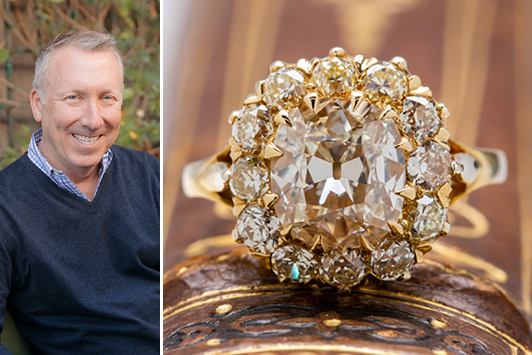
Where is the best place to source vintage engagement rings?
Trade shows like the Miami Beach Antique show, the Las Vegas Antique Show and the Metropolitan Show in New York offer quality and quantity in one place. Antique malls and the nicer flea markets are also good sources. The hardest rings to find are Edwardian and really nice Victorian rings; the easiest are styles from the 1930s and 1940s onward.
What types of antique and vintage engagement rings are most in demand?
About half our clients ask for yellow gold Victorian rings from the 1880s or 1890s, in a solitaire or simple halo style, and the other half love Art Deco. Edwardian rings are also very popular but are hardest to source. While we still do well with rings with colored stones, for the
past two years or so, the conversation has been more on diamonds.
The popular diamond shapes are antique cushion and antique marquise. People also like shapes with unusual proportions because they’re interesting.
Most antique or vintage stones have bigger facets and a big open culet in order to catch the rays of candlelight, which was the early source of indoor lighting.
What are the pitfalls to selling vintage engagement rings?
The major pitfall for jewelers just starting to carry vintage is not being able to restore antique and vintage rings properly. A lot of the filigree is very delicate. Sizing and repairing is not the same as with modern rings. Don’t be afraid to send it to jewelers who specialize in vintage and antique restoration.
Antique stones from vintage pieces were often sourced from India and Brazil, and much of that material is off-color, unlike diamonds from South Africa, Russia and Canada. Since most stones have not been removed to be certified, most people are surprised that they are L, M, N, O or top light brown. There’s nothing wrong with that, and we remind our clients that sourcing was much different 100 years ago. Jewelers would make the best of the diamonds they had to work with, placing them in intricate and delicate mountings that helped them appear whiter.
What are some pluses?
There are price advantages to dealing in vintage, where you are not paying to manufacture a ring at today’s labor costs. We often get questions about whether these rings are durable, and our answer: “Someone has loved it for the past 100 years, and it’s in beautiful condition, so it will last another 100 more.” We also point out that most vintage stones were mined long before the issue of conflict diamonds.
We like to talk about how the rings reflect historic periods. It puts customers at ease, and they connect to it. For instance, the tops of many Art Deco rings might resemble the Chrysler building or other skyscrapers being built then, really architectural with square lines.
During World War I and World War II, it was a sober time, and you saw very understated rings. During the war years, when jewelers had no access to platinum, white gold was used. In the 1940s, the postwar style was big and bold with a lot of colored stones.
We remind our clients that these rings have been loved for 50 to 150 years. And now it’s their time to love one, as will the generation after them.
Article from the Rapaport Magazine - August 2020. To subscribe click here.